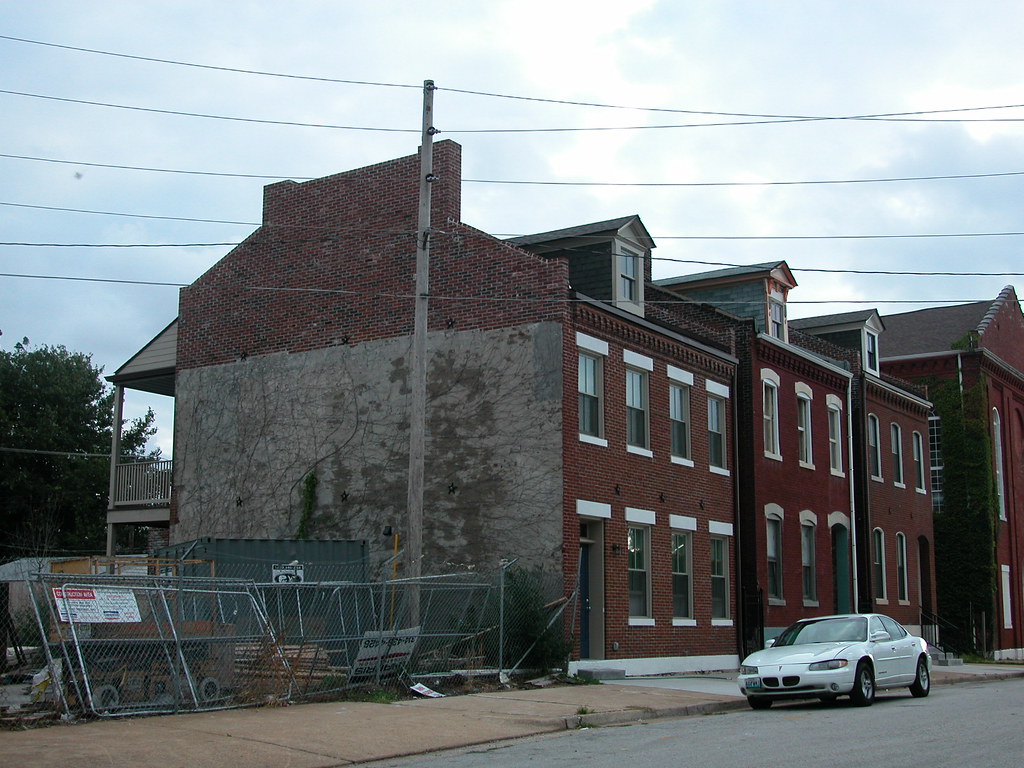 One gets the sense that the city of St. Louis cannot get a high wind without having a historic north side building crippled. This weekend, the remnants of Ike struck Old North St. Louis, causing more damage. Oddly, soon afterwards a truckload of St. Louis firemen arrived and struck the buidling with pressurized water spray for minutes, delving the final blow to the long-suffering house at 1219 Clinton Street. No one knows why the Fire Department showed up and performed pointless and destructive work. The vacant house had its first major blow back in the freak storm of July 2006. (See "A Dying House on Clinton Street", July 11, 2008.)
One gets the sense that the city of St. Louis cannot get a high wind without having a historic north side building crippled. This weekend, the remnants of Ike struck Old North St. Louis, causing more damage. Oddly, soon afterwards a truckload of St. Louis firemen arrived and struck the buidling with pressurized water spray for minutes, delving the final blow to the long-suffering house at 1219 Clinton Street. No one knows why the Fire Department showed up and performed pointless and destructive work. The vacant house had its first major blow back in the freak storm of July 2006. (See "A Dying House on Clinton Street", July 11, 2008.)Whereas some semblance of the front elevation remained intact throughout years of eroding fabric, now the house is a barely recognizable pile of materials destined for demolition. The loss had been inevitable for some time, although the opportunity for prevention was within reach until quite recently. The trouble with old buildings is that their economic rescue is calculated in price per square of rehabilitation, and once a building slips past a certain price it passes beyond the point of profit or even break-even. If a developer cannot break even, the only imperative for rehabilitation is a moral one. Even those who wish to lose money doing the right thing cannot do so if they don't have the money. No bank will finance a project that creates negative equity, no matter how much money the building could be worth in ten years.
The house on Clinton had passed the reasonable price-per-square-foot point awhile ago. Compounding its problems is the fact that it's the last house left on its block, and the other side of its block is faced with residences built in the 1980s.
Contrast the house on Clinton with some of the recent products of the ongoing Crown Square project. Four buildings on the 1300 and 1400 blocks of Warren Street are completed. Looking at the photographs below, one sees that these houses fit into streetscapes of other historic buildings. While these blocks are not fully intact, they are intact to the extent where further loss would be much more harmful than the loss of a single house on a block.


With limited funds available and the rules of finance at play, most developers are going to select to rehab buildings like those on Warren over the house on Clinton. By doing so, these developers aren't doing anything wrong. In fact, many bankers and developers would not even touch houses like those on Warren. The developers who did were non-profit organizations (the Regional Housing and Community Development Alliance and the Old North St. Louis Restoration Group). If it takes a non-profit to rehab the houses on Warren right now, it would have taken a charity to tackle the house on Clinton.
None off this explanation justifies the loss of a great house like the one on Clinton Street. Really, the loss could have been prevented if a new roof and boards had been installed three years ago. But who would have picked up the tab? Back then, the house had a private owner who had stopped paying taxes on the property. Alter, the city's Land Reutilization Authority owned the house. The first part was unwilling to do the right thing, the second unable.
Preservationists would be willing, be we aren't able. St. Louis lacks a bridge over the the preservation gap between the right thing and the possible thing. Can we build one?





7 comments:
If we had a fraction of that 100,000,000...
Has this place been targeted by brick thieves at all?
RHCDA and ONSLRG are charities.
Some brick thievery has hit 1219 Clinton, but mostly it has consisted of people stealing from the piles of bricks around the building.
RHCDA and ONSLRG are non-profit organizations, but they are not charities by mission or action.
Michael,
I think you might have just made $100.
This building was picked at by brick thieves over the years, but was hit very hard one last time earlier this summer. In fact, it was the last building hit by the brick theft crew caught by detectives of the brick theft task force, and the fact that we saw the theft and called it in aided in their investigation. Their ringleader was actually indicted last month. So, no matter how small, call brick theft in to 911 when you see it!
In order to qualify as a 501 c 3, an organization must qualify under either the charitable or educational purposes set out by the IRS.
Neither RHCDA nor ONSLRG are educational institutions, so they must be charities.
When seeking donations, both organizations promote the benefits of charitable contributions being made to either organization qualifying as tax deductible to the donor.
There's nothing wrong with being a charity. They serve a public purpose without being part of government. They are not profit motivated - they are motivated to carry out charitable purposes.
None of their directors receive any compensation. They all donate their time, and most donate financially to the organization as well.
If Landmarks Association of St. Louis is a 501c3, then it's also a charity, unless it attained its 501c3 status by qualifying under the educational provision of the IRS non-profit, 501c3 code.
Post a Comment